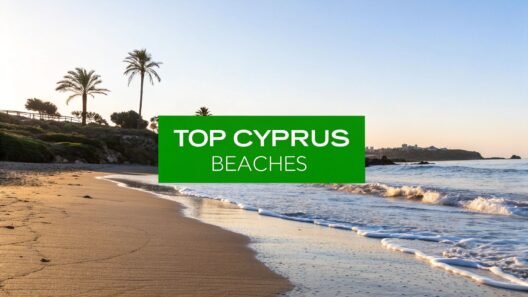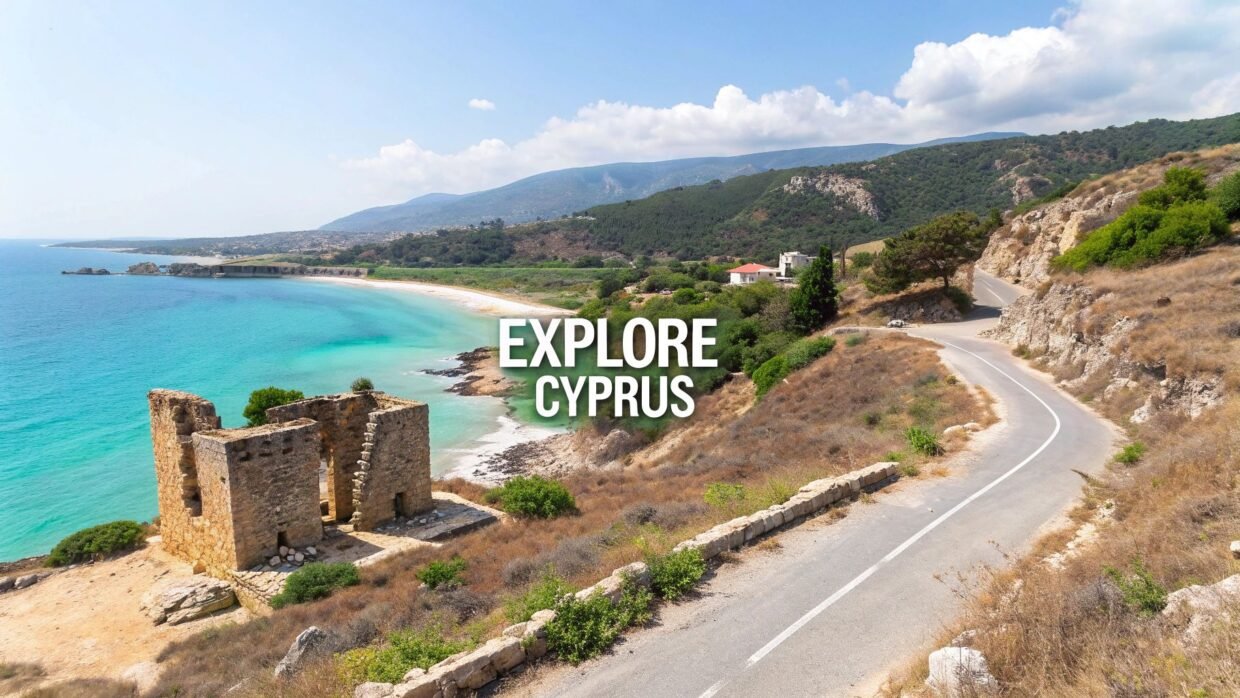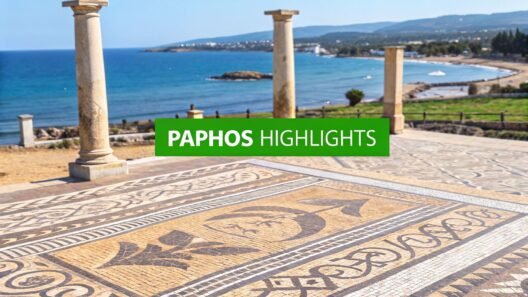Welcome to the jewel of the Mediterranean. Cyprus is an island of captivating contrasts, where ancient myths intertwine with vibrant modernity and sun-drenched coastlines give way to cool, pine-scented mountains. Whether you are a history enthusiast eager to walk through millennia-old ruins, a sun-seeker searching for the perfect turquoise bay, or a foodie ready to indulge in a traditional meze, this island offers a rich tapestry of experiences.
Deciding what to do in Cyprus can be the most challenging part of your holiday planning, simply because the options are so plentiful and diverse. This guide is designed to cut through the noise. We have curated a definitive list of the top 10 must-do activities that capture the true essence of the island, from the UNESCO-listed treasures of Paphos to the tranquil, timeless villages of the Troodos Mountains.
This is not a list of vague suggestions. Instead, we provide actionable tips and insider knowledge to help you craft an unforgettable Cypriot adventure. Forget generic advice; we will give you the practical details you need to explore this enchanting island like a seasoned traveller. Let's dive into the experiences that make Cyprus a destination you will want to return to year after year, covering everything from the divided capital of Nicosia to the underwater wonders of its premier dive sites.
1. Explore the Ancient City of Paphos and its Archaeological Treasures
A trip to Cyprus is incomplete without immersing yourself in the ancient world of Paphos, a city so rich in history that it is recognised as a UNESCO World Heritage site in its entirety. Once the island's capital during the Roman period, Paphos offers a remarkable journey back in time, making it an essential activity for anyone wondering what to do in Cyprus. Its historical significance is palpable, especially within the Kato Paphos Archaeological Park.
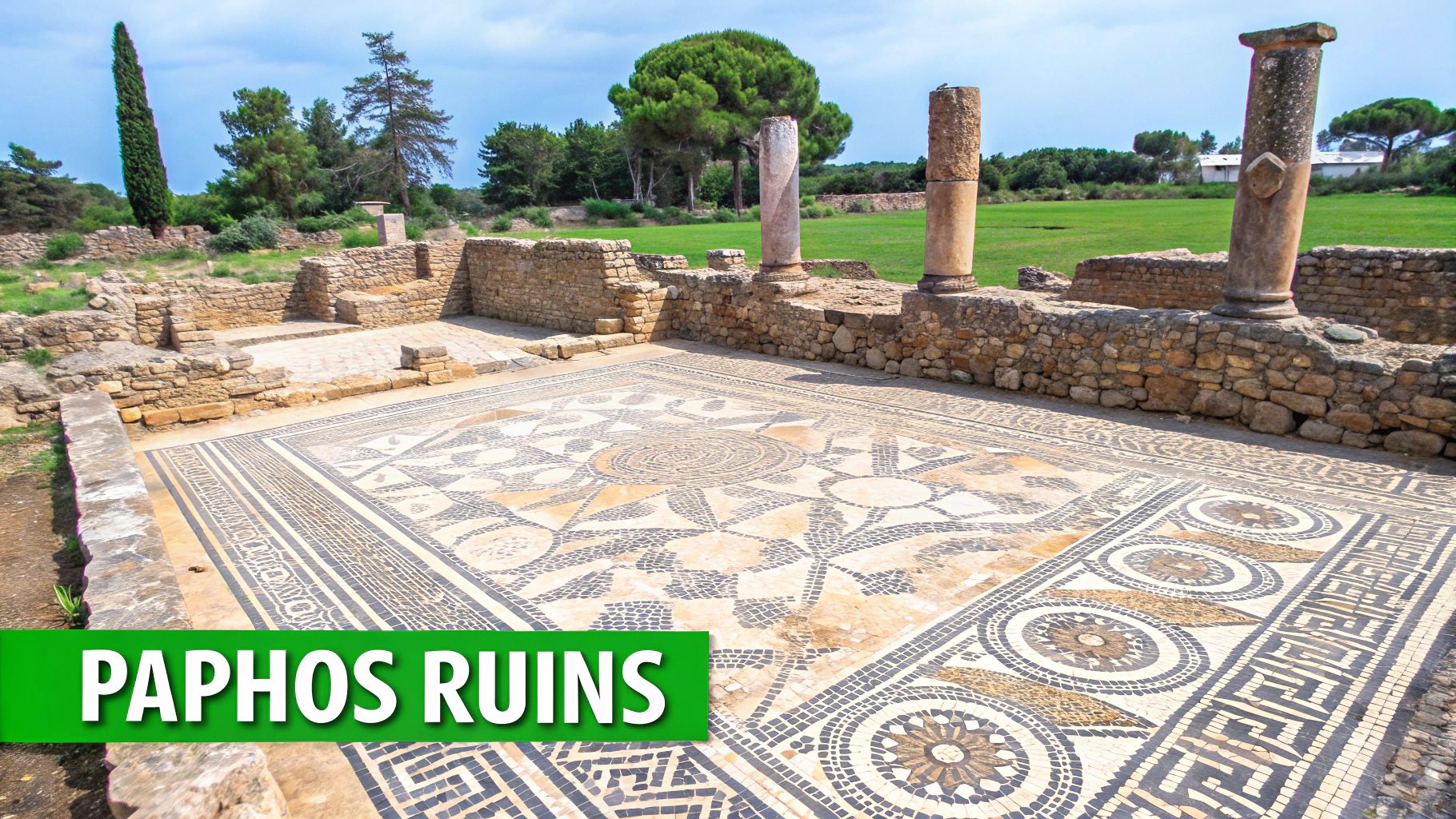
This sprawling open-air museum is home to some of the most well-preserved Roman mosaics in the Mediterranean. The intricate floors of ancient villas, such as the House of Dionysus, vividly depict scenes from Greek mythology with breathtaking detail and artistry. The park also contains the ruins of the Saranta Kolones (Forty Columns) castle, a 2nd-century Odeon theatre, and the ancient Asklepieion temple.
Must-See Sites in Paphos
A short distance from the main park lies the Tombs of the Kings, a vast necropolis carved directly from solid rock. These impressive underground chambers, dating back to the Hellenistic and Roman periods, served as the final resting place for high-ranking officials and aristocracy, not royalty as the name suggests. Wandering through these subterranean structures provides a hauntingly beautiful insight into ancient burial customs. The blend of these profound historical sites with the vibrant, modern harbour town makes Paphos a unique destination that caters to both cultural explorers and those seeking seaside leisure.
Practical Tips for Your Visit
To make the most of your exploration, consider these tips:
- Timing is Key: Visit the outdoor sites early in the morning or late in the afternoon to avoid the intense midday sun and the largest crowds.
- Dress Appropriately: Wear comfortable walking shoes, as you will cover a lot of ground. Sun protection, including a hat, sunglasses, and sun cream, is essential.
- Get the Best Value: Purchase a combination ticket that grants access to multiple archaeological sites for a reduced price.
- Plan Your Day: The guides at SayCyprus.com often recommend dedicating a full day to absorb the scale and beauty of Paphos's treasures without rushing.
2. Relax at Nissi Beach and Ayia Napa's Golden Shores
No list of what to do in Cyprus would be complete without mentioning the iconic Nissi Beach, the jewel in Ayia Napa's crown. Famed for its breathtakingly clear turquoise waters and powdery white sand, this Blue Flag-awarded beach is frequently ranked among the best in Europe. It’s the vibrant heart of the island’s beach culture, offering a perfect blend of relaxation, vibrant energy, and stunning natural beauty that captivates every visitor.
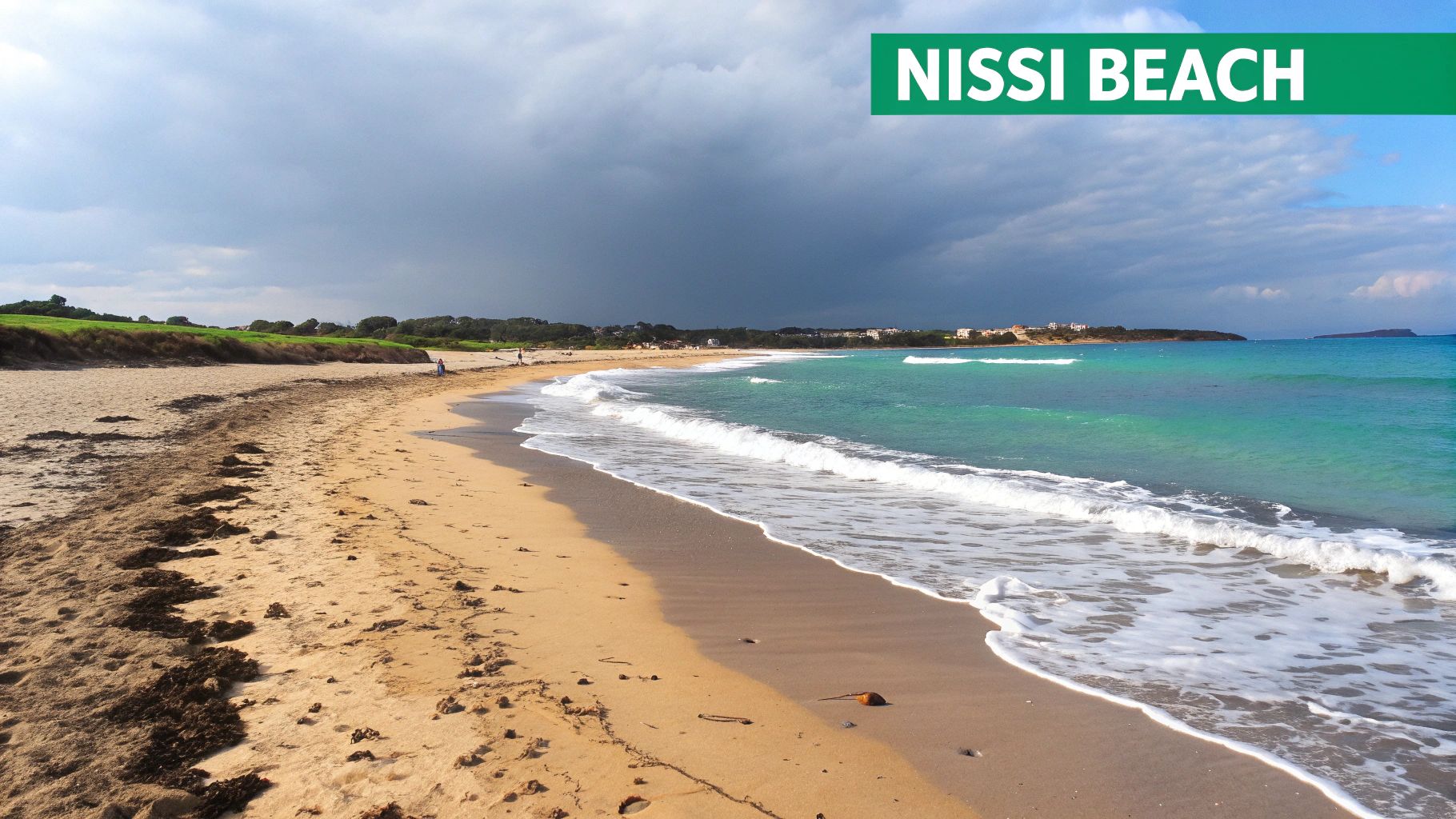
The beach's most distinctive feature is the small islet, Nissi, which is connected to the mainland by a temporary sandbar that appears and disappears with the tide. During low tide, you can easily walk across to explore the islet, adding a touch of adventure to your beach day. While it’s renowned for its lively atmosphere with beach bars and summer parties, the sheer beauty of the location makes it a must-visit for families and couples alike.
Must-Visit Shores in the Ayia Napa Area
While Nissi is the star, the surrounding coastline is dotted with equally spectacular beaches. A short drive away, you’ll find Fig Tree Bay in nearby Protaras, another world-class beach known for its calm, shallow waters and ancient, solitary fig tree. For a slightly more tranquil experience, Makronissos Beach offers a series of beautiful sandy coves, perfect for those looking to escape the biggest crowds while still enjoying fantastic amenities and water sports.
Practical Tips for Your Visit
To ensure a perfect beach day, keep these pointers in mind:
- Arrive Early: Nissi Beach is incredibly popular. Arrive before 10 am to secure a good spot on the sand and find convenient parking, especially during peak season.
- Protect the Reef: Use reef-safe sunscreen to help preserve the delicate marine ecosystem that makes the water so crystal-clear.
- Embrace Water Sports: The calm waters are ideal for trying activities like jet skiing, parasailing, or paddleboarding, with numerous vendors available along the shore.
- Explore Beyond the Buzz: If the main stretch feels too busy, walk towards the western end of the beach or visit nearby Makronissos for a more relaxed atmosphere.
3. Hike Through the Troodos Mountains and Visit Traditional Villages
To truly understand the heart of Cyprus, one must venture away from the sun-drenched coast and into the cool, pine-scented air of the Troodos Mountains. This majestic range, forming the island's green backbone, offers a refreshing contrast to the beach resorts and reveals a slower, more traditional way of life. Exploring this region is a vital experience for anyone seeking a comprehensive answer to "what to do in Cyprus," showcasing a completely different side of the island's character.
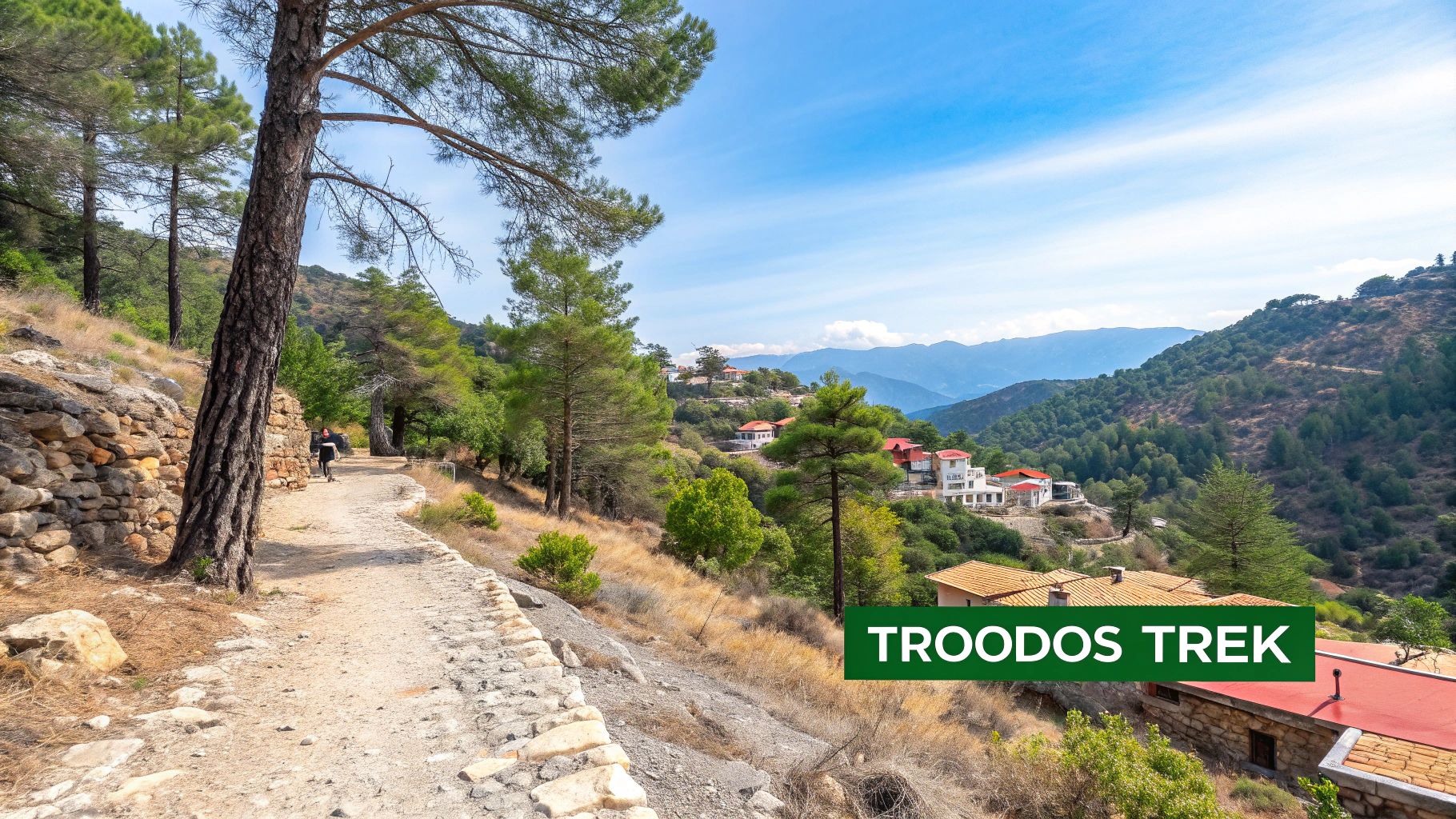
The Troodos region is a haven for nature lovers and cultural enthusiasts alike, dotted with walking trails that meander through dense forests to stunning waterfalls like Caledonia and Millomeris. The area is also home to ten UNESCO-listed painted Byzantine churches, whose unassuming stone exteriors hide interiors covered in vibrant, historically significant frescoes. These cultural treasures are scattered among charming stone villages where time seems to stand still.
Must-See Sites in the Troodos Mountains
A highlight of any mountain excursion is visiting traditional villages like Omodos, renowned for its cobbled streets, local lacework, and welcoming wineries offering tastings of local wines and the potent zivania spirit. Further into the mountains, the world-famous Kykkos Monastery stands as a testament to faith and artistry, housing a revered icon of the Virgin Mary. The blend of spectacular natural scenery, profound religious history, and authentic village life makes the Troodos Mountains an unmissable destination. For a deeper dive into the area's highlights, you can find more information about the Troodos mountains and villages on SayCyprus.com.
Practical Tips for Your Visit
To ensure a seamless mountain adventure, keep these suggestions in mind:
- Rent a Car: Public transport is limited, and a car offers the freedom to explore remote villages and trailheads at your own pace.
- Dress in Layers: The temperature can drop significantly with altitude, even on a warm day. Packing a light jacket or jumper is wise.
- Try Local Delicacies: Be sure to sample regional specialities, including freshly made halloumi, sweet soutzoukos, and trout from local mountain farms.
- Check Opening Times: Many of the smaller painted churches have specific visiting hours. It's best to check in advance to avoid disappointment.
4. Discover the Divided Capital of Nicosia
A visit to Nicosia (Lefkosia) offers one of the most unique and thought-provoking experiences in Europe, as it stands as the continent's last divided capital city. The city is split by the UN-patrolled "Green Line" separating the Republic of Cyprus in the south from the Turkish-occupied north. Exploring Nicosia is an essential activity for anyone wondering what to do in Cyprus, providing a profound look into the island’s complex modern history alongside centuries of layered culture within its magnificent Venetian walls.
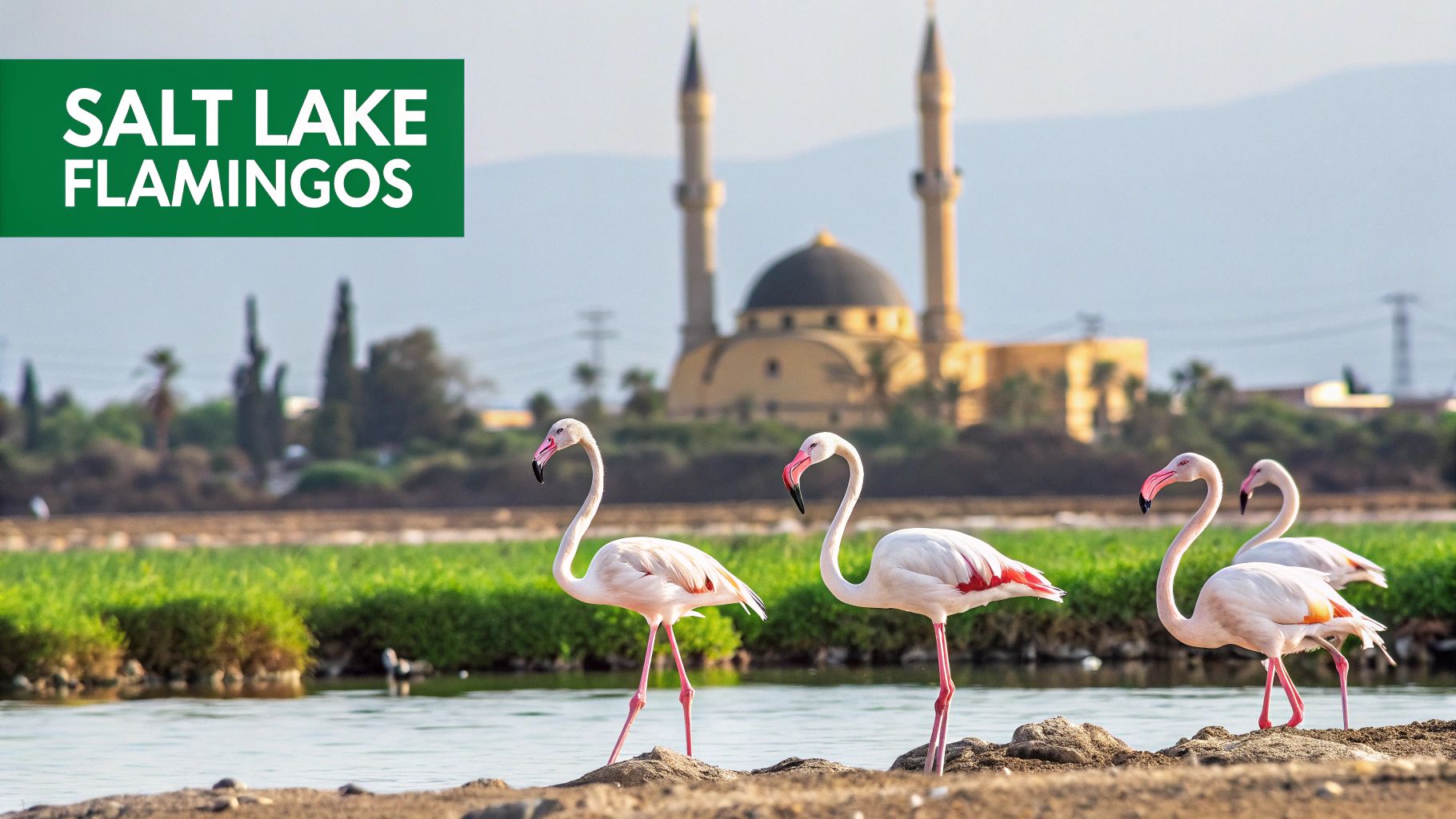
The historic Old City, encircled by 16th-century fortifications, is a maze of narrow streets where echoes of Lusignan, Venetian, and Ottoman rule are found at every turn. On the southern side, you can explore the impressive Cyprus Museum, home to the island's most significant collection of archaeological antiquities. In contrast, crossing the Ledra Street checkpoint into the northern part reveals a distinct atmosphere, with highlights like the stunning Selimiye Mosque (formerly the Cathedral of Saint Sophia) and the beautifully restored Büyük Han, a 16th-century caravanserai now filled with artisan shops and cafés.
Must-See Sites in Nicosia
The experience of crossing the buffer zone on foot is a destination in itself, offering a tangible sense of the city's division. Once across, the contrast is immediate and fascinating. For panoramic views of this divided landscape, ascend the Shacolas Tower Observatory on the southern side, which provides a clear perspective of the entire city, including the Green Line and the occupied northern territory. Wandering through both parts of the Old City offers a compelling narrative of a capital that is both historically united and politically divided, a true living museum. For more detailed guidance, there are many excellent resources available detailing things to do in Nicosia.
Practical Tips for Your Visit
To ensure a smooth and respectful visit, keep these points in mind:
- Bring Your Passport: A valid passport or EU ID card is mandatory for crossing the checkpoint into the northern part of the city.
- Respect Photography Rules: Be mindful of restrictions, especially near the UN buffer zone and military posts. Photography is strictly forbidden in these sensitive areas.
- Best Time to Cross: Use the designated crossing points, like Ledra Street, during daylight hours for ease of navigation and to experience both sides fully.
- Embrace Local Culture: Take time to relax in a traditional coffee shop (kafenio) in the Old Quarter to soak in the local atmosphere and observe daily life.
5. Experience Larnaca's Rich History and Salt Lake Flamingos
Often the first port of call for visitors thanks to the island's main international airport, Larnaca is far more than just a gateway. The city offers a captivating blend of ancient history, natural wonders, and authentic Cypriot charm, making it a key destination for those deciding what to do in Cyprus. Its relaxed, palm-lined promenade and rich cultural tapestry provide a fantastic introduction to the island's diverse appeal.
Larnaca’s historical significance is deeply rooted in its past as the ancient city-kingdom of Kition. This heritage is wonderfully preserved and accessible, most notably at the magnificent Church of Saint Lazarus. This 9th-century stone church was built over the reputed tomb of Lazarus of Bethany, the man resurrected by Jesus. Inside, you can visit the tomb and admire the ornate iconostasis. Just a short walk away, you can explore the ancient Kition archaeological site, uncovering the foundations of a city that has stood for over 3,000 years.
Must-Do Activities in Larnaca
One of Larnaca's most spectacular seasonal attractions is the Salt Lake. During the winter months, this network of lakes becomes a crucial wetland habitat, attracting thousands of greater flamingos that stop here on their migratory path. Seeing the flocks of vibrant pink birds against the serene backdrop of the Hala Sultan Tekke mosque is an unforgettable sight. Beyond the natural beauty, the old Turkish quarter, Skala, offers a glimpse into traditional life with its charming streets, artisan workshops, and authentic tavernas.
Practical Tips for Your Visit
To ensure a memorable trip to Larnaca, keep these suggestions in mind:
- Flamingo Spotting: The best time to see the flamingos is from December to March. Early morning or late afternoon light provides the best conditions for photography.
- Cultural Exploration: Combine a visit to Saint Lazarus Church with a walk through the nearby Skala quarter to find traditional pottery workshops and enjoy a meal at a local eatery.
- Strategic Base: Larnaca's central location makes it an excellent base for exploring other parts of the island, with easy access to Nicosia, Ayia Napa, and the nearby Choirokoitia Neolithic settlement.
- Plan Your Day: You can easily explore the main city sights on foot. The Salt Lake and Hala Sultan Tekke are a short drive or a longer, scenic walk from the city centre.
6. Adventure Sports and Activities in Akamas Peninsula
For those with an adventurous spirit seeking raw, untamed nature, the Akamas Peninsula is an unmissable destination. This vast, protected national park on the westernmost tip of Cyprus represents the island's last great wilderness. It offers a stunning landscape of rugged coastlines, deep gorges, and rare flora and fauna, making it a prime location for thrilling outdoor activities and a fantastic answer for anyone asking what to do in Cyprus beyond the resorts.
The peninsula’s challenging terrain means many of its most beautiful spots are inaccessible by conventional car, preserving their pristine condition. This creates a perfect playground for 4×4 off-roading, quad biking, and hiking. The rewards for venturing into this area are immense, from discovering hidden coves with crystal-clear water to encountering the island's unique wildlife, including the protected green and loggerhead turtles at Lara Bay.
Must-Experience Adventures in Akamas
The legendary Baths of Aphrodite, a natural grotto shaded by a fig tree, marks the start of a popular nature trail offering panoramic views. For a more intense challenge, hiking the Avakas Gorge provides a spectacular experience, navigating a narrow limestone canyon with towering walls. The ultimate prize is a trip to the Blue Lagoon, a breathtaking bay with turquoise waters so vibrant they seem unreal, perfect for swimming and snorkelling.
Practical Tips for Your Akamas Expedition
To ensure a safe and enjoyable adventure, proper planning is crucial:
- Choose Your Transport Wisely: Rent a 4WD vehicle or a quad bike for independent exploration, or join an organised jeep safari tour to have a guide lead the way.
- Stay Hydrated and Protected: The Akamas has minimal facilities. Carry plenty of water, especially for hiking, and use high-factor sun cream, a hat, and sunglasses.
- Respect the Wildlife: Be mindful of Lara Bay's turtle nesting sites, particularly between May and August. Do not disturb the marked nests or use umbrellas on the beach.
- Time Your Activities: Begin hikes or off-road journeys early in the morning to avoid the scorching midday heat, especially during the summer months.
7. Scuba Diving and Snorkeling at Premier Underwater Sites
Beneath its sun-drenched shores, Cyprus conceals a mesmerising underwater world, making it a premier destination for both scuba divers and snorkellers. The island is renowned for some of the clearest waters in the Mediterranean, with visibility often reaching an incredible 30-40 metres. Exploring this submerged realm is an unforgettable experience and a top recommendation for anyone considering what to do in Cyprus, offering everything from spectacular shipwrecks to vibrant marine ecosystems.
The eastern coast, particularly around Ayia Napa and Protaras, is a hub for underwater adventures suitable for all skill levels. The warm, calm sea conditions for most of the year create a perfect environment for beginners to take their first breaths underwater, while advanced divers can explore dramatic caves, tunnels, and one of the world's most famous wreck dives. The diversity of sites ensures that every dive or snorkel session offers a unique perspective on the island’s hidden beauty.
Must-Explore Underwater Sites
The undisputed jewel in Cyprus's diving crown is the MS Zenobia wreck near Larnaca. This colossal Swedish roll-on-roll-off ferry sank on its maiden voyage in 1980 and now rests on its side, fully laden with its cargo of over 100 lorries. It is consistently ranked among the top ten wreck dives globally. For those seeking natural formations, the Amphitheatre Caves in Protaras offer a stunning open-top cavern, while the shallow waters of Green Bay are perfect for novice divers and snorkellers to spot turtles, trumpetfish, and moray eels.
Practical Tips for Your Dive
To ensure a safe and remarkable underwater journey, keep these tips in mind:
- Get Certified: If you aren't already certified, consider completing your theory online before you arrive to maximise your time in the water. Most dive centres offer PADI or SSI courses.
- Choose Reputable Operators: Book your dives with a well-reviewed, professional dive centre. They will provide well-maintained equipment and have expert knowledge of local conditions and marine life.
- Check the Season: While diving is possible year-round, the best conditions are from April to October when the water is warmest and marine life is most active.
- Capture the Moment: Many dive centres offer underwater photography courses or hire out cameras, allowing you to bring home stunning images of your adventure.
8. Wine Tasting Tours in Cyprus's Ancient Wine Regions
Delving into Cyprus's rich viticultural heritage offers a sensory journey unlike any other, revealing a wine-making tradition that stretches back over 5,000 years. For travellers seeking an authentic taste of the island's culture, embarking on a wine tasting tour is an essential activity when considering what to do in Cyprus. The island is home to unique indigenous grape varieties, such as the robust red Maratheftiko and the crisp white Xynisteri, which thrive in the sun-drenched mountain slopes.
The experience is anchored by Commandaria, a sweet amber-coloured dessert wine that holds the title of the world's oldest named wine still in production. Exploring the designated "Commandaria" region feels like stepping back in time, with historic wineries and charming villages dotting the landscape. Beyond this legendary sweet wine, Cyprus’s modern wine scene is flourishing, with boutique producers like the Tsiakkas Winery in the Pitsilia region offering contemporary takes on ancient grapes, alongside established giants such as KEO.
Must-Try Wine Experiences
A highlight of any wine tour is visiting the traditional villages that form the heart of the "Krasochoria" or wine villages. Omodos, with its cobbled streets and historic monastery, is not only visually stunning but also home to numerous family-run wineries and cooperatives where you can sample local vintages. Combining a cultural tour of these mountain villages with stops at nearby wineries provides a beautifully balanced day of history, scenery, and flavour.
Practical Tips for Your Visit
To ensure a smooth and enjoyable wine tasting adventure, keep these recommendations in mind:
- Book in Advance: Many boutique wineries operate by appointment only, so it is wise to call or book your tour ahead of time to guarantee a spot.
- Designate a Driver: Your safety is paramount. Always arrange for a designated non-drinking driver, hire a taxi, or join an organised tour.
- Explore Local Grapes: Be adventurous and ask to sample indigenous varieties. This is your chance to taste wines you will not find anywhere else.
- Buy Direct: Purchasing a few bottles directly from the producers not only supports the local economy but also provides a wonderful souvenir of your trip. The team at SayCyprus.com offer insights into the best wine tours to help you plan your itinerary.
9. Explore Traditional Villages and Local Culture
To truly understand the heart of Cyprus, you must venture away from the bustling coastal resorts and into the island's charming traditional villages. Nestled in the Troodos Mountains or scattered across the rural countryside, these settlements preserve centuries-old traditions, architecture, and a slower pace of life. Exploring these villages is a rewarding activity for anyone wondering what to do in Cyprus, offering an authentic glimpse into the island's soul, far from the tourist crowds.
Villages like Lefkara, famous for its intricate lacework (Lefkaritika) and filigree silver, and Omodos, a picturesque wine-making hub with a cobbled square, transport you to another era. Here, you can wander through narrow stone-paved alleys, admire traditional houses with terracotta roofs and wooden balconies, and observe artisans at work. This connection to living history and local craftsmanship provides a profoundly different, yet equally essential, Cypriot experience.
Must-Visit Villages and Experiences
Beyond the most famous spots, consider visiting Tochni, a village known for its unique stone architecture and pottery workshops where you can try your hand at the craft. For an even deeper historical dive, the nearby Choirokoitia Neolithic settlement, a UNESCO World Heritage site, reveals how people lived on the island over 9,000 years ago. Each village offers a unique flavour, from the wine cellars of Omodos to the lace-making demonstrations in Lefkara, creating a rich tapestry of Cypriot culture.
Practical Tips for Your Village Tour
To enhance your cultural immersion, keep these suggestions in mind:
- Embrace Local Etiquette: Learning a few basic Greek phrases like "kalimera" (good morning) or "efcharisto" (thank you) is appreciated. Always ask for permission before photographing locals or their private property.
- Support Local Artisans: Purchase authentic crafts directly from the creators. This ensures you get a genuine souvenir while supporting the local economy and preserving these traditional skills.
- Dine Authentically: The best way to experience local cuisine is at a village taverna. Order a traditional meze meal to sample a wide variety of Cypriot dishes in one sitting.
- Plan Your Route: Many of these villages are located in mountainous terrain. Renting a car is the most flexible option, allowing you to explore at your own pace and discover hidden gems along the way.
10. Visit Ancient Salamis and Famagusta in Northern Cyprus
A journey to the northern part of the island reveals some of Cyprus's most profound historical layers, making a visit to ancient Salamis and the walled city of Famagusta an essential consideration for what to do in Cyprus. This excursion offers a different perspective on the island's complex history, combining magnificent ancient ruins with compelling medieval architecture and modern political realities. It's a day trip that promises deep historical insight and unforgettable sights.
The ancient city of Salamis, once a powerful city-kingdom, boasts extensive Greco-Roman ruins that rival those found anywhere in the Mediterranean. As you wander through its vast archaeological site, you can explore a remarkably preserved Roman theatre, a sprawling gymnasium with its Palaestra, and intricate Roman baths. Nearby, the St. Barnabas Monastery and its icon museum provide another layer of religious and cultural history, dedicated to the founder of the Cypriot Orthodox Church.
Must-See Sites in the Region
Just a short drive from Salamis is the medieval city of Famagusta, enclosed by formidable Venetian walls that remain largely intact. Within these walls, you can discover the Lala Mustafa Pasha Mosque, a stunning example of Gothic architecture originally built as the Cathedral of Saint Nicholas. Famagusta is also known for the ghost town of Varosha, a former bustling tourist resort abandoned since 1974. Viewing its silent, decaying hotels from the designated areas is a sobering and unique experience, offering a stark glimpse into the island’s more recent, turbulent past.
Practical Tips for Your Visit
To ensure a smooth and enriching trip to the north, keep these points in mind:
- Border Crossing: Remember to bring your passport or EU ID card for crossing the border from the south. Crossings are straightforward but necessary.
- Currency: While some places may accept Euros, the official currency is the Turkish Lira (TRY). It's advisable to exchange some money for better value.
- Photography Rules: Be respectful of signage and avoid taking pictures of military personnel or installations, particularly around the Varosha fence line.
- Guided Tours: Consider hiring a guide or joining an organised tour from companies like SayCyprus.com to gain a deeper understanding of the complex history and context of the sites.
Top 10 Cyprus Attractions Comparison
| Experience | 🔄 Implementation Complexity | ⚡ Resource Requirements | 📊 Expected Outcomes | 💡 Ideal Use Cases | ⭐ Key Advantages |
|---|---|---|---|---|---|
| Explore the Ancient City of Paphos and its Archaeological Treasures | Moderate – multiple sites, ticketing | Moderate – entry fees, walking effort | High – rich historical knowledge & visuals | History enthusiasts, cultural tourism | UNESCO site, well-preserved mosaics & ruins |
| Relax at Nissi Beach and Ayia Napa's Golden Shores | Low – straightforward beach access | Moderate – parking, beach amenities | High – relaxation, recreational activities | Beach lovers, water sports, nightlife seekers | Crystal-clear waters, Blue Flag certification |
| Hike Through the Troodos Mountains and Visit Traditional Villages | Moderate to High – transport and trail navigation | Moderate – rental car, hiking gear | High – cultural immersion & nature exposure | Adventure seekers, culture and nature lovers | UNESCO churches, traditional villages, hiking |
| Discover the Divided Capital of Nicosia | Moderate – border crossing, urban touring | Low to Moderate – passport needed, walking | High – unique political and cultural insight | History buffs, geopolitical interest | Only divided capital, rich museums and architecture |
| Experience Larnaca's Rich History and Salt Lake Flamingos | Low – city and nature site access | Low – easy access, minimal entry | Moderate – birdwatching, historical sites | Bird watchers, casual explorers | Nearby airport, flamingos, historical mix |
| Adventure Sports and Activities in Akamas Peninsula | High – requires 4WD, physical exertion | High – specialized vehicle, supplies | High – wilderness and wildlife encounters | Outdoor adventurers, nature photographers | Pristine wilderness, rare flora & fauna |
| Scuba Diving and Snorkeling at Premier Underwater Sites | High – certification, equipment needed | High – rental or personal dive gear | High – marine biodiversity and underwater views | Marine life enthusiasts, certified divers | Clear waters, historic wrecks, diverse dive sites |
| Wine Tasting Tours in Cyprus's Ancient Wine Regions | Moderate – booking and transport needed | Moderate – transport, tasting fees | High – cultural and sensory experience | Wine lovers, cultural tourists | Ancient winemaking, unique indigenous grapes |
| Explore Traditional Villages and Local Culture | Moderate – transport and interaction | Moderate – rental car, local guides optional | High – authentic cultural exposure | Cultural travelers, craft and food lovers | Intact traditions, handmade crafts, local cuisine |
| Visit Ancient Salamis and Famagusta in Northern Cyprus | Moderate to High – border crossing & touring | Moderate – passport, transport, minimal fees | High – historical and political learning | History and political tourism | Well-preserved ruins, unique political significance |
Crafting Your Perfect Cyprus Itinerary
From the sun-drenched ruins of ancient Paphos to the tranquil, pine-scented trails of the Troodos Mountains, we've journeyed across an island of breathtaking contrasts. This guide has offered you a curated glimpse into the very soul of Cyprus, showcasing ten distinct experiences that form the cornerstones of an unforgettable adventure. Yet, the real magic lies not in simply ticking off a list, but in how you weave these diverse threads together to create your own unique Cypriot story.
The answer to the question of what to do in Cyprus is never a single, static itinerary. It's a dynamic tapestry that you design yourself, reflecting your personal travel style and passions. Cyprus is a rare destination where you can start your day stepping back thousands of years at a UNESCO World Heritage site and end it with your feet in the sand at a world-class beach club in Ayia Napa. This ability to blend ancient history with modern leisure, and rugged nature with refined culture, is the island's greatest strength.
Key Takeaways for Your Cyprus Adventure
To truly make the most of your trip, remember the power of combination. Don't limit yourself to one region or one type of activity. Instead, embrace the island’s compact size to create a journey full of rich and varied experiences.
- Blend History and Relaxation: Pair a morning exploring the Tombs of the Kings in Paphos with an afternoon relaxing by the sea. Follow a day uncovering the Venetian walls of Nicosia with a peaceful evening at a traditional taverna in a nearby village.
- Combine Mountains and Coast: The Troodos Mountains are just a short drive from the southern coast. You can easily spend a morning hiking to a hidden waterfall and be back on the coast in Larnaca or Limassol for a sunset stroll along the promenade.
- Mix Culture and Cuisine: A wine-tasting tour through the Krasochoria (wine villages) is not just about the wine; it’s a deep dive into the local culture. Enhance this by seeking out local specialities like halloumi cheese or traditional souvla, connecting the island's flavours directly to its landscape and heritage.
Expert Insight: The most memorable Cypriot holidays are built on contrast. A day spent exploring the raw, unspoiled nature of the Akamas Peninsula can be perfectly balanced by indulging in the sophisticated culinary scene of Limassol the next. It’s this blend that creates a truly holistic and enriching travel experience.
Planning Your Next Steps
Now, the adventure truly begins. Use this listicle as your foundation. Select the two or three experiences that resonate most deeply with you and build your itinerary around them.
- Prioritise Your Must-Sees: Are you an avid historian, a beach lover, or a nature enthusiast? Identify your top priorities. If ancient history is your passion, make Paphos and Kourion your anchors. If you’re seeking sun and sea, centre your trip around Ayia Napa and Protaras.
- Map Your Journey: Look at a map of Cyprus. Notice how accessible everything is. You could base yourself in a central location like Limassol and take day trips in every direction, or you could plan a road trip that takes you on a loop around the island.
- Embrace Spontaneity: While planning is essential, leave room for the unexpected. You might discover a charming village not on your list, hear about a local festival, or simply decide to spend an extra day on a beach you’ve fallen in love with. Cyprus rewards the curious traveller.
Ultimately, your journey through Cyprus is a personal one. It is an island that reveals its secrets slowly, rewarding those who venture beyond the beaten path. Whether you find your bliss watching flamingos at the Larnaca Salt Lake, exploring the poignant division of Nicosia, or diving into the crystal-clear waters near Cape Greco, Cyprus offers a profound and lasting impression. The island is ready for you; all that's left is for you to begin crafting your perfect itinerary.
Ready to turn your dream Cyprus trip into a reality? At SayCyprus, we specialise in providing in-depth guides, local insights, and practical tools to help you plan your journey. Explore SayCyprus to find detailed articles on every location mentioned here and start building the adventure of a lifetime.








